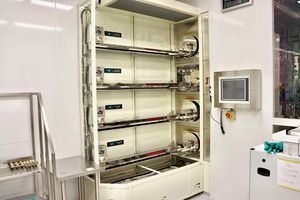Sandvik Furnace Stack
 |
|
| Tool Name | Sandvik Furnace Stack |
|---|---|
| Instrument Type | Deposition |
| Staff Manager | Sam Azadi |
| Lab Location | Bay 2 |
| Tool Manufacturer | Ultratech/Cambridge |
| Tool Model | S200 |
| NEMO Designation | {{{NEMO_Designation}}} |
| Lab Phone | XXXXX |
| SOP Link | SOP |
Description
The Sandvik LPCVD consists of 4 furnace tubes:
Tube 1: Wet/Dry Silicon Oxide deposition. Wet/Dry oxide: This tube uses the Si substrate to grow SiO2. Wet oxide refers to the use of water vapor as the source of oxygen and dry oxide uses O2 gas. Since water molecules can penetrate through the substrate more, wet oxide technique results in thicker oxides and faster growth rate. Wet oxide deposition on the tool is limited to 5 hours.
Tube 2: Low Stress Silicon Nitride deposition. This tube is designated to low stress silicon nitride. Deposition rate of the standard recipe on the tool is ~ 490 nm/hour with thin film stress of ~ 60 MPa for a 1-hour run. The films deposited via, LPCVD have a higher resistance towards CF4 etch and make better etch masks. In an RIE system with CF4 etch, LPCVD silicon nitride is etched at the rate of 50 nm/min vs 80 nm/min for PECVD silicon nitride. The etch rate for LPCVD silicon nitride film in 49% HF at room temperature is ~ 2.5 nm/min.
Tube 3: Clean anneal. This tube is an RCA clean wafer only anneal tube, with N2 and H2N2 gases.
Tube 4: General anneal. This tube is a general anneal tube, with N2 and H2N2 gases
Applications
- Wet/Dry Silicon Oxide deposition
- Low Stress Silicon Nitride deposition
- Annealing with N2 or H2N2 gases